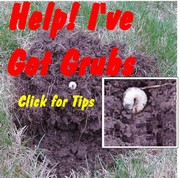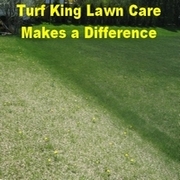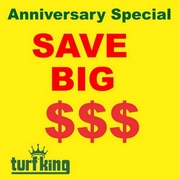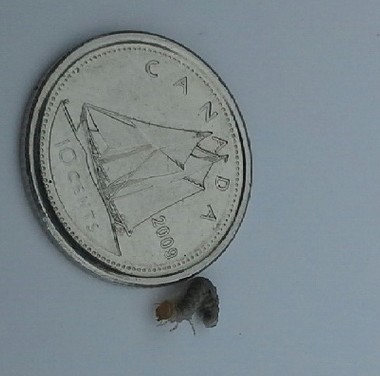
Baby grubs found! July 3/13- hatched already?
When I sent photos to some experts- a couple of entomologists and a turf specialist- here's what they said
I think, it is a May/June beetle grub. The adult beetle typically emerge from soil in May/June and lay eggs, those eggs hatch in June/July. - Thurka
- Was just thinking about this. It is damn early. Maybe they are June beetle grubs. Adults would have emerged 2-4 weeks ago -Pam
- I am thinking that it may be first instar May/June beetles. -Stacey
To Sod or Not to Sod?
Sometimes homeowners want to know, “Can my lawn be saved? Should I just sod it and start over?” Often the lawn has been neglected or has been damaged by insects or is just plain weedy.
So, what are the pros and cons? What are the reasons and considerations in putting in a new lawn versus getting a lawn care program and working slowly on the lawn?
In a nutshell, it’s Time versus Money.
If money is no object, putting in a new lawn is the easy choice. As long as you do it properly, you start off with a lawn that is in good shape, is nice and dense, weed-free, green and healthy.
Getting your lawn sodded of course will cost more. Here are a few of the advantages. You don’t have to wait for the seed to grow and fill in. Your children and dogs can use it relatively soon –as soon as the soil beneath is stable and not squishy. The sod you lay down has been growing for 18 to 24 months since it was seeded.
There may be times when sodding is a good thing to do. If the lawn is terribly uneven or if the slope and grade are not right, re-sodding gives you the opportunity to correct these faults. If there has been a lot of machinery going over the lawn when the pool was installed or some new landscaping installed, then rototilling will be an excellent way to alleviate all that compaction.
But if the lawn is reasonably well drained and if it does not slope so water accumulates in the basement, then seeding is less costly. It will take some time for the seed to fill in, but if you don’t need the lawn to look perfect for the wedding guests coming next month, then seeding can also have some advantages.
Generally speaking, a seeded lawn has more vigour than a sodded lawn. It is grown in place. It has not been grown elsewhere and transplanted to your yard. It can be grown with more varieties of grasses. Sod is most often grown as 100% Kentucky bluegrass. One reason is that bluegrass forms a nice patchwork of roots so the sod doesn’t fall apart. Other grasses do not form a nice piece of sod.
A lawn containing several grass species is more resistant to disease. It is more adaptable to various conditions. And if your lawn is heavily shaded, Kentucky bluegrass sod will not survive well in shade. With seeding you can choose seed that is formulated to better withstand shady conditions.
Weeds are a problem whether you seed or sod. In the “old days,” one could spray the weeds and grass with Roundup and kill off all the existing weeds. Nowadays, it is not legal to use Roundup to kill weeds in this situation. Rototilling will chop up the soil and most weeds. Two weeds that can be a problem with rototilling are quack grass and Canada thistle. This is because both of these weeds have a lot of underground roots that grow sideways underneath and send up new plants a few inches to a foot away. And when you rototill them up, you are just creating hundreds of little roots. Many of those roots have the potential to become plants (read weeds.)
If you opt to seed, you will save a considerable amount of money versus having the sod professionally installed. If you are sodding yourself, it will cost you in sweat and exercise (which can be a good thing for some.) In a few cases where the lawn is extremely small, such as a lawn that is smaller than the parking space for a car, sodding such a small area is not much more work than seeding.
When it comes to seeding a lawn, there are a number of ways to do seeding. This link has information on seeding.
If you would like Turf King to seed your lawn, our preferred method is to aerate and overseed.
Here are some links that give you info on that process.
Sent this photo to the MOE in April 11/13 after seeing a flyer. Roundup is not permitted to be used except for poisonous plants like poison ivy. Don't see much poison ivy growing on hard surfaces.
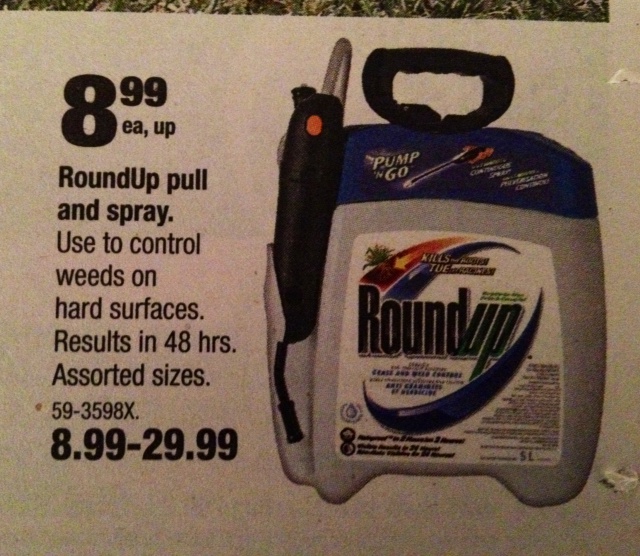
|
Ministry |
Ministère |
|
|
Standards Development Branch |
Direction de lélaboration des normes |
|
|
40 St. Clair Ave. West 7th Floor Toronto ON M4V 1M2 |
40, avenue St. Clair ouest 7e étage Toronto ON M4V 1M2 |
|
|
Tel.: 416 327-5519 |
Tél.: 416 327-5519 |
SENT ON BEHALF OF STEVE KLOSE, DIRECTOR
June 27, 2013
E-mail: This email address is being protected from spambots. You need JavaScript enabled to view it.
Thank you for your e-mail of April 11, 2013 about the requirements for the sale and use of RoundUp products in Ontario. I have been asked to respond to your enquiry on behalf of the Honourable Jim Bradley, Minister of the Environment.
Ontario’s cosmetic pesticides ban took effect April 22, 2009. The ban prohibits Ontario families and children from the unnecessary risks of cosmetic pesticides. More than 100 pesticide ingredients are banned for cosmetic uses such as on lawns, gardens, parks and school yards. Only biopesticides and certain lower-risk pesticides are allowed for controlling weeds and pest in lawns and gardens.
Under the ban, RoundUp products are Controlled Sales products that require licensed vendors selling these products to provide a Class 7 Handout to purchasers informing them that certain uses of these products are not allowed under the ban.
RoundUp products cannot be used on driveways, patios, lawns or gardens to control weeds or other vegetation as these are cosmetic uses, but can be used to control plants poisonous to humans by touch (e.g., poison ivy, giant hogweed). Furthermore, controlled sale products must be offered for sale (advertised) in accordance with Ontario Regulation 63/09 made under the Pesticides Act.
When the ministry becomes aware or receives a report of suspected non-compliance with respect to the sale or use of prohibited pesticides, the ministry assesses each situation on a case by case basis to determine if the activity is in compliance with the legislation and to determine an appropriate response. The ministry has a variety of compliance and enforcement tools available to help ensure that individuals are adhering to the requirements under the ban.
In response to your question of whether the specific advertisement you provided is in compliance with the pesticides legislation, the ministry will be reviewing the advertisement with our legal department to determine compliance with the pesticides legislation.
To report suspected non-compliance with the requirements of the cosmetic pesticides ban, I would encourage you to contact your local ministry district office during regular business hours (look in the Blue Pages in your telephone directory or see a listing on the ministry’s web site at www.ene.gov.on.ca). After business hours contact the ministry’s Pollution Hotline at 1-866-MOE-TIPS (1-866-663-8477).
Thank you for your enquiry regarding RoundUp products.
Sincerely,
Steve Klose
Director








